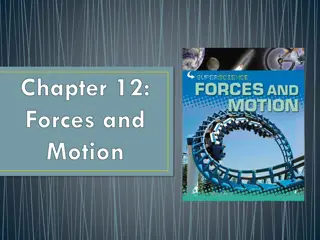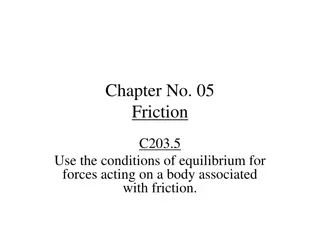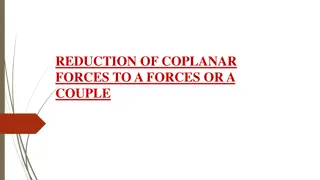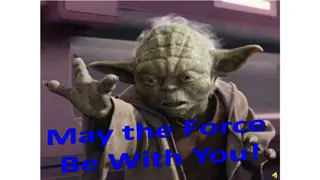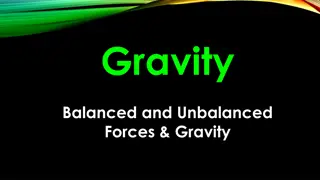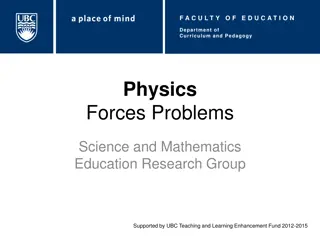Understanding Action and Reaction Forces in Physics
Explore the concept of action and reaction forces in physics through examples like a falling boulder and interactions between different masses. Understand how forces are equal and opposite, leading to accelerations based on mass and force interactions. Discover the relationship between Earth and the moon's gravitational forces and how forces impact acceleration in varied mass scenarios.
Download Presentation

Please find below an Image/Link to download the presentation.
The content on the website is provided AS IS for your information and personal use only. It may not be sold, licensed, or shared on other websites without obtaining consent from the author. Download presentation by click this link. If you encounter any issues during the download, it is possible that the publisher has removed the file from their server.
E N D
Presentation Transcript
7.3 IDENTIFYING ACTION 7.3 IDENTIFYING ACTION AND REACTION AND REACTION
7.3 Identifying Action and Reaction Sometimes the identity of the pair of action and reaction forces in an interaction is not immediately obvious. For example, what are the action and reaction forces in the case of a falling boulder? If we call the action Earth exerting a force on the boulder , then the reaction is the boulder simultaneously exerting a force on Earth .
7.3 Identifying Action and Reaction When action is A exerts force on B, the reaction is simply B exerts force on A.
7.3 Identifying Action and Reaction think! We know that Earth pulls on the moon. Does the moon also pull on Earth? If so, which pull is stronger? Answer: Both Earth and moon pull on each other with equal and opposite forces.
7.4 Action and Reaction on Different Masses A given force exerted on a small mass produces a greater acceleration than the same force exerted on a large mass.
7.4 Action and Reaction on Different Masses Earth is pulled up by the boulder with just as much force as the boulder is pulled down by Earth.
7.4 Action and Reaction on Different Masses Although the pair of forces between the boulder and Earth is the same, the masses are quite unequal. Acceleration is not only proportional to the net force, but it is also inversely proportional to the mass. a=F/m Because Earth has a huge mass, we don t sense its small acceleration.
7.4 Action and Reaction on Different Masses Force and Mass When a cannon is fired, there is an interaction between the cannon and the cannonball. The force the cannon exerts on the cannonball is exactly equal and opposite to the force the cannonball exerts on the cannon.
7.4 Action and Reaction on Different Masses The cannonball undergoes more acceleration than the cannon because its mass is much smaller.
7.4 Action and Reaction on Different Masses F represents both the action and reaction forces; m (large), the mass of the cannon; and m (small), the mass of the cannonball. Do you see why the change in the velocity of the cannonball is greater compared with the change in velocity of the cannon?
7.4 Action and Reaction on Different Masses The balloon recoils from the escaping air and climbs upward.
7.4 Action and Reaction on Different Masses If a balloon is released and allowed to move, it accelerates as the air comes out. A rocket accelerates in much the same way it continually recoils from the exhaust gases ejected from its engine.
7.4 Action and Reaction on Different Masses A common misconception is that a rocket is propelled by the impact of exhaust gases against the atmosphere. NOT TRUE! Both the rocket and recoiling cannon accelerate because of the reaction forces created by the cannonballs they fire air or no air. In fact, rockets work better above the atmosphere where there is no air resistance.
7.4 Action and Reaction on Different Masses The rocket recoils from the molecular cannonballs it fires and climbs upward.
7.4 Action and Reaction on Different Masses think! A tug of war occurs between boys and girls on a polished floor that s somewhat slippery. If the boys are wearing socks and the girls are wearing rubber-soled shoes, who will surely win, and why?
Answer:The girls will win. The force of friction is greater between the girls feet and the floor than between the boys feet and the floor. When both the girls and the boys exert action forces on the floor, the floor exerts a greater reaction force on the girls feet. The girls stay at rest and the boys slide toward the girls.



